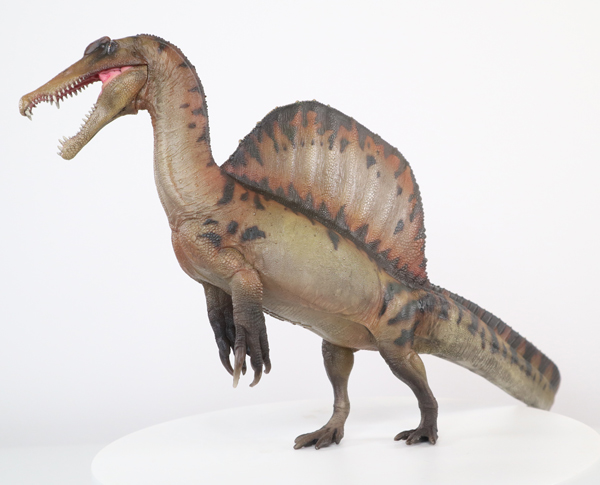PNSO Aymen the Spinosaurus YouTube Video Script
Everything Dinosaur has recently published a short video reviewing the PNSO Aymen the Spinosaurus dinosaur model. The video also summarised recent research into this remarkable theropod. In September 2014, researchers published an influential paper that postulated that Spinosaurus was an obligate quadruped. That is, unlike all the other theropods known to science, Spinosaurus was not a biped. It walked on all fours.
Model makers were keen to develop Spinosaurus aegyptiacus figures that reflected this research.
Picture credit: Everything Dinosaur
Ten Years of Spinosaurus Research
Spinosaurus aegyptiacus has been the focus of intense research over the last ten years. Its mode of locomotion, diet and behaviour have come under detailed scrutiny. Palaeontologists remain uncertain as to whether this dinosaur was an aquatic animal. The 2014 paper (Ibrahim et al) postulated that Spinosaurus was semiaquatic. It spent a considerable amount of time in or around water. Earlier research had demonstrated that Spinosaurus was probably a piscivore. What proportion of its diet comprised fish remains unknown.
Given the large number of super-sized predators within the palaeoenvironment, it has been suggested that Spinosaurus became specialised in order to avoid competition. This is a form of niche partitioning.
The Everything Dinosaur video review of the PNSO Aymen the Spinosaurus figure summarises some of this recent research.
Visit Everything Dinosaur’s YouTube channel (please subscribe): Everything Dinosaur on YouTube.
The reconstruction of Spinosaurus aegyptiacus as a quadruped attracted criticism. Some scientists commented upon the lack of more complete fossil specimens representing individual animals. The researchers led by Nizar Ibrahim reconstructed Spinosaurus using several different fossil specimens. The scaling of some of the bones used in the reconstruction caused concern.

Life-size reconstruction and supplemental figure. Picture credit: Davide Bonadonna (top) Ibrahim et al (bottom)
Tracing Spinosaurus Research with PNSO Figures
Spinosaurus figures have been part of the PNSO model range for many years. A 1/35th scale Scientific Art figure (below) was an early addition to the company’s dinosaur portfolio. This dinosaur figure was referred to as “Essien”. A model of a baby Spinosaurus was also included in the company’s prehistoric animal model series.
A second “Essien” the Spinosaurus model was introduced by PNSO in 2020. In 2022, the 1:35 scale model was revamped and relaunched in a new colour scheme. It still depicted Spinosaurus as an obligate theropod. Changing perceptions about this dinosaur can be traced through the evolution of PNSO Spinosaurus figures.
PNSO Aymen the Spinosaurus
This year (2024), a new Spinosaurus model has been introduced by PNSO. The PNSO Aymen the Spinosaurus figure reflects some of the latest scientific thinking. It has a broad tail as demonstrated in a scientific paper published in 2020 (Ibrahim et al). It is presented as a bipedal dinosaur (walking on its hind legs).
A spokesperson from Everything Dinosaur stated:
“Spinosaurus is likely to intrigue palaeontologists for many years. The absence of an articulated and more complete fossil specimen representing an individual animal is hampering research. The new PNSO Aymen the Spinosaurus broadly reflects the current scientific thinking. That is, until the next Spinosaurus aegyptiacus fossil find.”
To view the range of PNSO prehistoric animal models in stock: PNSO Age of Dinosaurs.

The stunning new for 2024 PNSO Aymen the Spinosaurus dinosaur model. Picture credit: Everything Dinosaur.
Picture credit: Everything Dinosaur
Ironically, the day Everything Dinosaur received a PNSO delivery, a new paper was published that challenged the findings of earlier research. Potential measurement errors were highlighted in a study originally published in 2022 that concluded that Spinosaurus had dense bones to help it dive and submerge. As team members were unloading the lorry, news of the publication of the latest Spinosaurus paper broke.
Visit the user-friendly Everything Dinosaur website: Everything Dinosaur.
To read Everything Dinosaur’s blog post about the 2014 scientific paper: Spinosaurus – Four Legs are Better than Two!
The scientific paper: “Semiaquatic adaptations in a giant predatory dinosaur” by Nizar Ibrahim, Paul C. Sereno, Cristiano Dal Sasso, Simone Maganuco, Matteo Fabbri, David M. Martill, Samir Zouhri, Nathan Myhrvold and Dawid A. Iurino published in Science.



